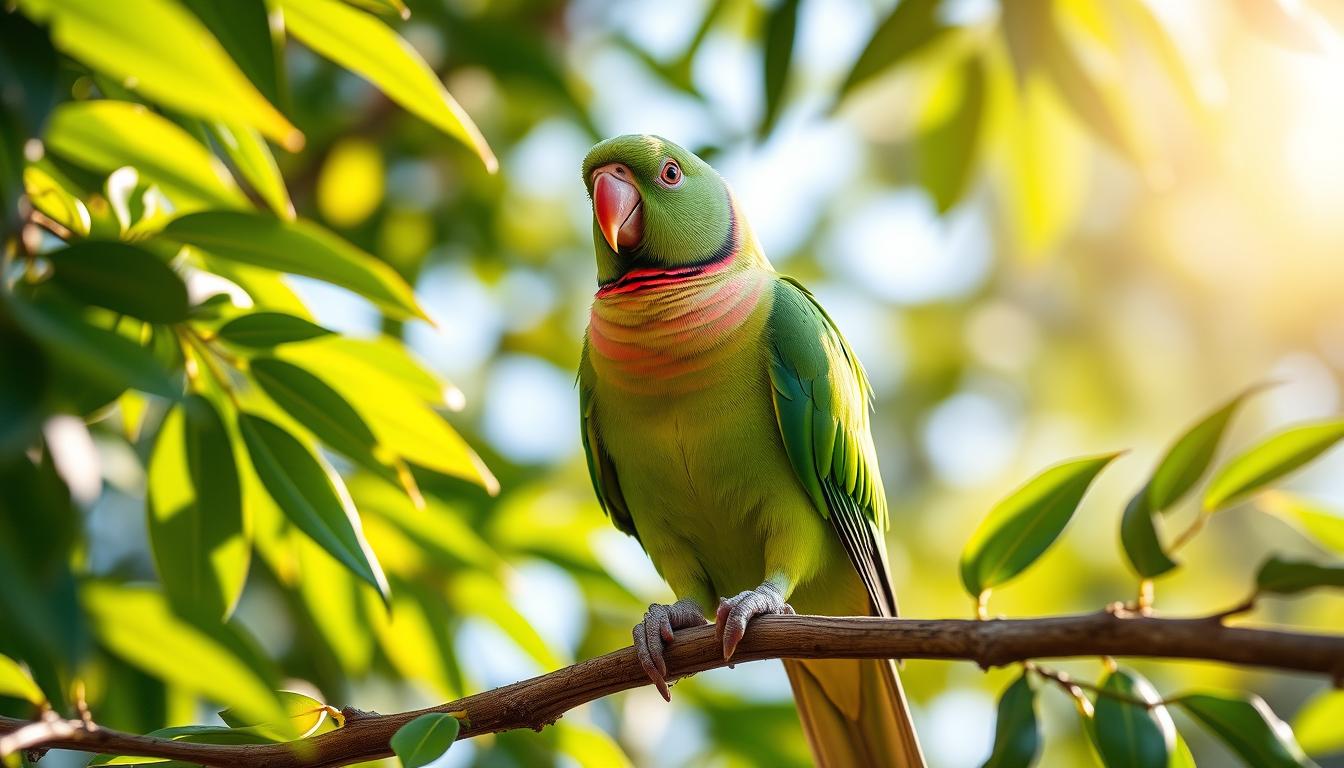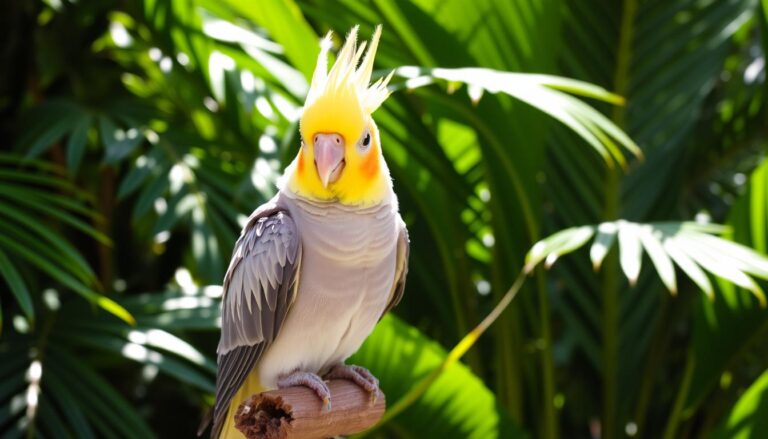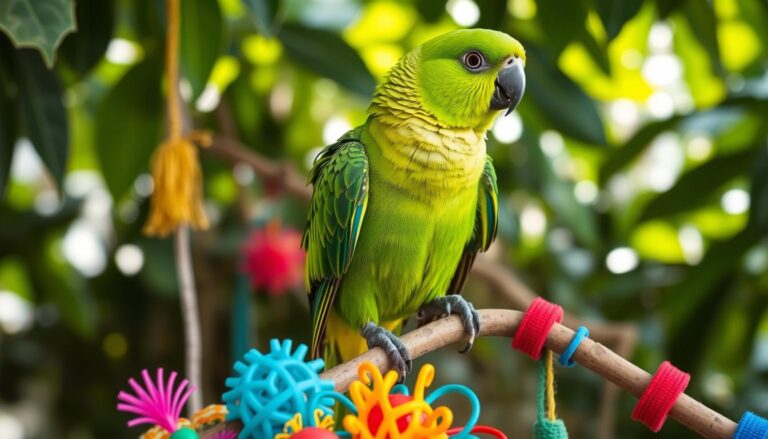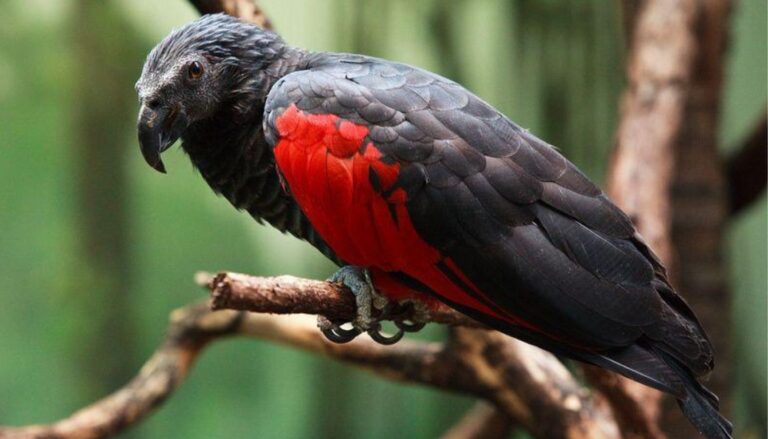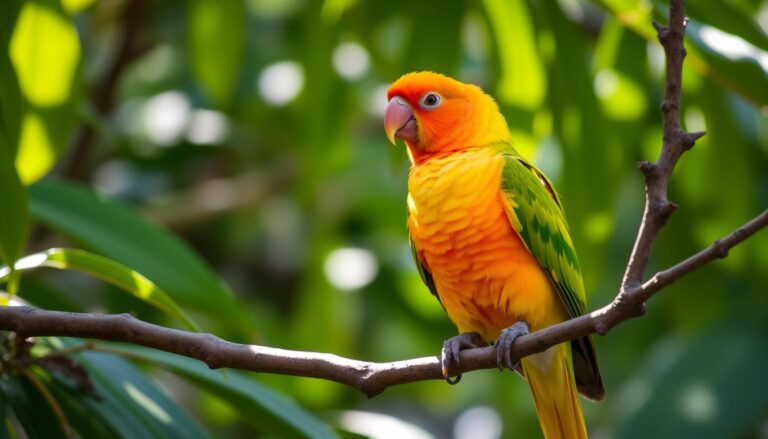General Information About Rose-Ringed Parakeet
The Rose-Ringed Parakeet (Psittacula krameri) is a colorful and medium-sized parrot. It is known for its striking looks and lively personality. This parakeet comes from Africa and South Asia and has made homes in cities worldwide, including the United States.
It’s a favorite among bird lovers, so knowing how to care for it is key. This article will cover the Rose-Ringed Parakeet’s physical traits, where it lives, what it eats, and how it behaves.
Introduction to the Rose-Ringed Parakeet
The Rose-Ringed Parakeet, also known as the Ring-Necked Parakeet, is a favorite among bird lovers. It’s known for its elegant look and lively spirit. This avian species is popular as a pet because it fits well in social settings and homes.
Its bright colors and amazing voice add to its charm. An introduction to rose-ringed parakeet shows its stunning feathers and its ability to make beautiful sounds.
Parakeets need careful and informed parakeet care to do well in a home. They are smart and fun, making great friends. But, they also need special attention from their owners.
Knowing what they need helps create a happy bond between the bird and its caregiver. This makes caring for a Rose-Ringed Parakeet a fulfilling experience.
Physical Characteristics of the Rose-Ringed Parakeet
The rose-ringed parakeet has unique physical traits that make it stand out. These traits, like size, weight, and color, help identify them. They also make them popular pets.
Size and Weight
Adult rose-ringed parakeets are 16 to 18 inches long, including their tails. They weigh between 4 to 6 ounces. Males are bigger than females, showing a slight difference in size.
As they grow older, a rose-colored ring around their neck becomes more visible. This ring is a key feature of the adult parakeet.
Color Variations
Rose-ringed parakeets come in a variety of colors. The wild ones have bright green bodies and yellowish bellies. Through selective breeding, many color variations have been created.
Some common colors include blue, lutino, and grey. These colors make the parakeets very attractive to pet owners and bird lovers.
Habitat and Distribution
The rose-ringed parakeet is very adaptable. It lives in many places, from dry lands to green forests and even cities. They love areas with lots of trees and bushes, like forests, woodlands, and farms.
These birds are found in the Indian subcontinent and parts of Africa. They have also moved to places like Europe and the United States. This shows how well they can adjust to new places.
Diet and Nutrition of the Rose-Ringed Parakeet
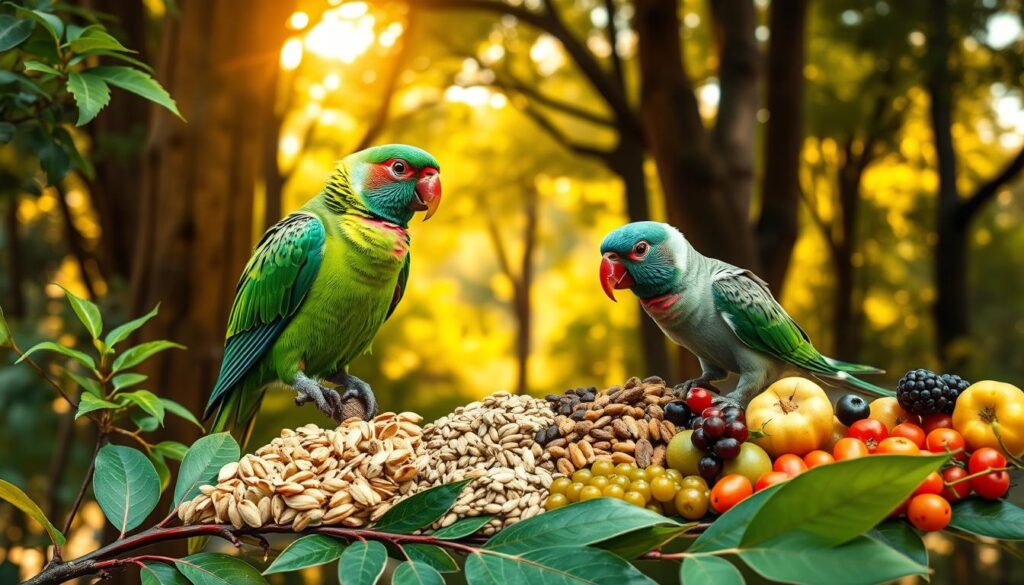
The diet and nutrition of the rose-ringed parakeet are key to their health. Knowing their natural diet helps in feeding them well as pets. In the wild, they eat a variety of foods that keep them vibrant.
Natural Diet
Rose-ringed parakeets mainly eat seeds, berries, fruits, and nuts. They use their strong beaks to crack open hard seeds and fruits. Experts say they need a mix of carbs, vitamins, and minerals to stay healthy and active.
Feeding in Captivity
Feeding rose-ringed parakeets in captivity needs careful thought. A good diet includes high-quality pellets, fresh fruits, and veggies. Avoid foods like avocado, chocolate, and caffeine as they are toxic. Giving them different foods keeps them healthy and prevents nutritional problems.
Behavioral Traits
Rose-ringed parakeets are lively and engaging. They show many social behaviors that show their natural instincts and ability to adapt. These traits make them charming as pets.
Social Behaviors
Rose-ringed parakeets love to live in groups. In the wild, they do well with lots of friends. This helps them feel part of a community.
In homes, they also enjoy being around people. It’s important to keep them company to prevent loneliness. This helps them stay happy and healthy.
Vocalization and Communication
Rose-ringed parakeets are known for their playful voices. They make all sorts of sounds, like whistles and chatter. This makes them fun to have around.
Talking to them helps them learn and keeps them mentally sharp. They can even learn to mimic human speech. This makes them special to many bird lovers.
Reproduction and Breeding
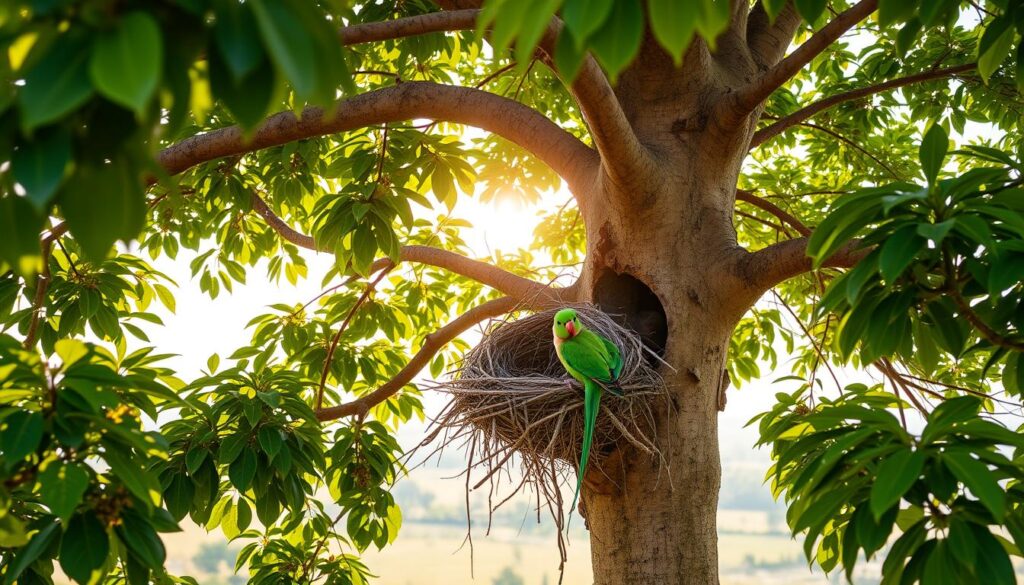
Rose-ringed parakeets have complex ways of reproducing and breeding. They have special behaviors during the breeding season. These behaviors help them find a mate.
The mating rituals of these birds are quite elaborate. Males and females show off through courtship actions. This is how they choose each other.
Mating Rituals
Male rose-ringed parakeets have unique mating rituals. These rituals are key to their breeding success. They include:
- Preening to show off their grooming skills and look good.
- Offering food to show they can care for their mate.
- Making special calls to mark their territory and attract females.
These rituals help form strong bonds. This ensures successful pairings that can last for many breeding seasons.
Nesting Habits
Rose-ringed parakeets look for safe and easy-to-reach places to nest. They prefer hollowed-out trees and cliff cavities. They usually lay 3 to 6 eggs, which both parents incubate.
The incubation period is about 23 days. After that, the young parakeets fledge and leave the nest in a few weeks. It’s important to have the right breeding conditions for their survival.
Popular Pet Care Tips for Rose-Ringed Parakeets
Proper care for rose-ringed parakeets means meeting their housing and grooming needs. These birds need a comfortable and healthy environment. Regular maintenance is key to their well-being.
Housing Requirements
A spacious and secure cage is vital for rose-ringed parakeets. Aim for a cage that’s at least 24” x 24” x 36” in size. It should have various perches, toys, and easy-to-reach food and water.
Enough space lets them fly and play. This is important for their health and happiness.
Grooming and Maintenance
Grooming rose-ringed parakeets is essential. A cuttlebone helps keep their beaks healthy. Regular nail trimming prevents discomfort from overgrowth.
They also need chances to bathe. Mist them or provide shallow water for feather and skin care.
Health Considerations
Rose-ringed parakeets can face many health issues. It’s important to know about these problems and how to prevent them. This helps keep them happy and healthy for a long time. Issues like feather plucking, breathing problems, and being too fat are common.
Watching for sudden changes in how they act or eat is key. These can be signs of bigger health problems.
Common Health Issues
Feather plucking can happen due to stress, boredom, or health issues. Breathing problems might come from bad air, changes in humidity, or harmful things. Being too fat usually means they’re eating too much and not moving enough.
Staying alert can help catch these problems early. This makes sure they get the care they need to stay healthy.
Preventative Care
Preventative care for rose-ringed parakeets includes good food, vet visits, and a clean home. Eating the right food helps keep them strong. Going to the vet regularly helps catch health problems early.
Keeping their home clean is also important. Toys and social time help keep them happy and stress-free. This reduces problems like feather plucking and being too fat.
The Role of Rose-Ringed Parakeets in Culture
Rose-ringed parakeets hold a special place in many cultures worldwide. They are seen as symbols of prosperity, joy, and love. Their lively presence is often found in myths and folklore, showing them as messengers of companionship.
In history, these birds have been cherished pets. Their role in human emotion is significant. This shows their importance as beloved companions.
These birds have appeared in art and literature for centuries. Artists have painted and sculpted them, celebrating their beauty. Writers have used them in stories, symbolizing loyalty and affection.
Today, rose-ringed parakeets are valued as intelligent companions. They are loved for their beauty and engaging personalities. This love strengthens their cultural significance, making them important in the history of pets.
Training Your Rose-Ringed Parakeet
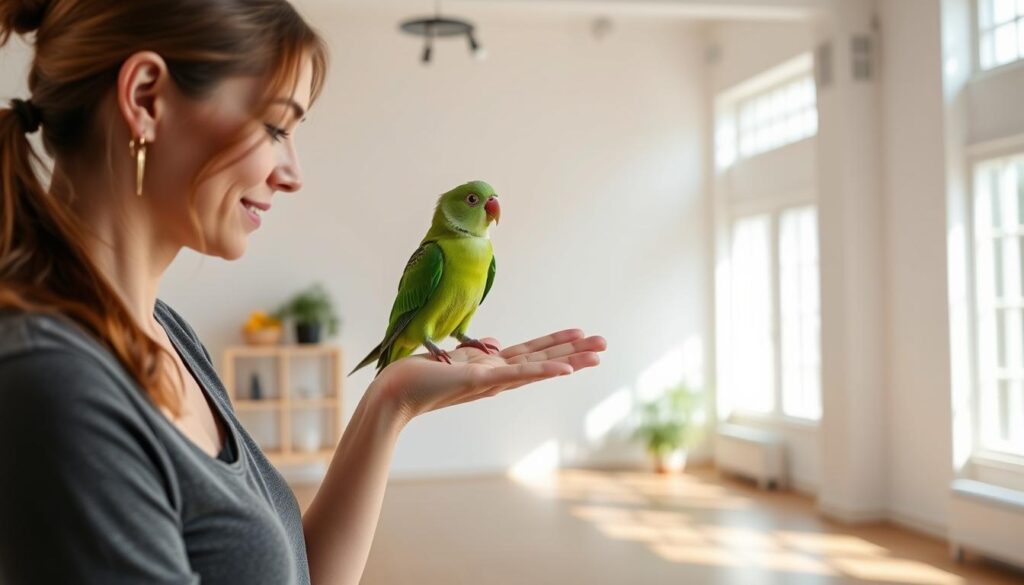
Training your rose-ringed parakeet can make your bond stronger and your pet easier to manage. It requires regular practice and positive rewards. With the right techniques, you can teach your parakeet basic commands and improve their behavior.
Basic Commands
Teaching basic commands to a rose-ringed parakeet takes patience and repetition. Commands like “step up” and “come here” work well with treats as rewards. This helps the parakeet learn to associate words with actions.
Regular practice helps the bird to do these commands well over time. It builds a strong foundation for communication.
Behavior Modification Techniques
Behavior modification helps with issues like too much screeching or aggression in rose-ringed parakeets. Giving them stimulating toys and activities is key. This keeps them busy and away from bad behaviors.
Using training techniques like redirecting bad actions and rewarding good ones helps. It shapes better habits in your parakeet.
Conservation Status of the Rose-Ringed Parakeet
The Rose-Ringed Parakeet is listed as a species of Least Concern by the International Union for Conservation of Nature (IUCN). This means it’s not currently at high risk globally. Yet, some local threats can harm its numbers. A big worry is habitat loss due to deforestation and urban growth. These changes reduce the natural spaces they need to live.
Illegal trapping for the pet trade also hurts their numbers. Many places struggle to control this, leading to too many birds being caught. To help, efforts are underway to protect their homes. These plans aim to keep the species safe and thriving for the future.
To ensure the Rose-Ringed Parakeet’s survival, we need to protect their habitats and stop illegal trapping. Raising awareness can help communities and others understand the importance of protecting these birds. This knowledge can lead to better actions to safeguard their future.
Interesting Facts About Rose-Ringed Parakeets
Rose-ringed parakeets are known for their unique personalities. They show off their intelligence and social side through fun antics. Owners love watching them roller-skate, hang upside down, and play with toys.
These behaviors show they need mental challenges and a rich environment. They are more than pets; they are interactive friends.
Unique Behaviors
The special behaviors of rose-ringed parakeets are key to their happiness. Owners should:
- Give them different toys to keep their minds sharp.
- Play with them to boost their social skills.
- Help them explore and climb to follow their natural instincts.
These steps create a happy and fulfilling life for them.
Longevity
Rose-ringed parakeets can live from 15 to 25 years with proper care. Good pet care includes a healthy diet, regular vet visits, and keeping their minds active. This shows the big commitment needed to keep these colorful birds happy for a long time.
Conclusion and Final Thoughts on Rose-Ringed Parakeets
The rose-ringed parakeet is a charming and loving bird that can bring happiness to any home. It’s important to know their needs, behaviors, and how to care for them if you’re thinking of getting one. By creating a good environment for them, you can make sure they are happy and healthy.
Rose-ringed parakeets live a long time and are very playful. This makes them more than just pets; they are wonderful friends. With the right care, these colorful birds can bring joy and love into your life for many years. They love to interact with people and their surroundings, making their bond with owners even stronger.
If you’re thinking of getting a rose-ringed parakeet, learn how to take good care of them. This will help them grow and thrive. Getting to know their unique personalities will create a special bond between you and your bird. This is key to responsible pet ownership.

